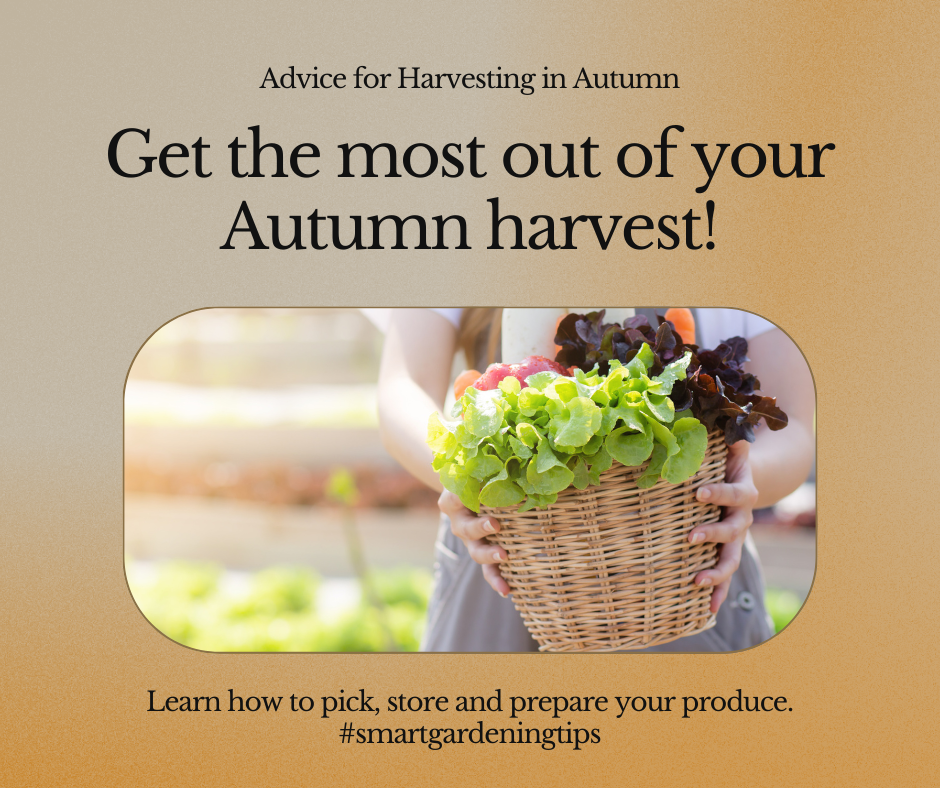
Welcome to our expert guide on autumn harvesting! As the leaves change colors and the temperatures cool down, it’s time to prepare for a bountiful season of harvesting. Whether you’re a seasoned gardener or just starting out, this article will provide you with valuable tips, best practices, and tools to maximize your yield during this fruitful time of year.
Key Takeaways:
- Prepare your garden for autumn crops to ensure a fruitful harvest.
- Choose the right crops that thrive during this season.
- Implement effective preservation techniques to store your harvested produce.
- Invest in the essential tools and equipment needed for efficient harvesting.
- Care for your autumn harvest properly to maintain its freshness and quality.
Importance of Autumn Harvesting
When it comes to gardening, autumn is a crucial season for harvesting. The importance of autumn harvesting cannot be overstated, as it offers numerous benefits for both your garden and your overall produce yield. Harvesting during the autumn season allows you to take advantage of optimal growing conditions and reap the rewards of your hard work throughout the year.
One of the key benefits of autumn harvesting is the abundance of crops that thrive during this season. Many vegetables and fruits, such as pumpkins, apples, and root vegetables, reach their peak flavors and nutritional value in the autumn months. By harvesting during this time, you can enjoy the freshest, tastiest produce from your own garden.
Additionally, autumn harvesting enables you to make the most out of your garden space. By clearing out mature plants, you create room for new growth, ensuring a continuous cycle of productivity. This cycle allows you to maximize your yield and keep your garden space utilized all year round.
The autumn season also presents ideal conditions for storing and preserving harvested produce. The cool temperatures and lower humidity levels during this time provide the perfect environment for prolonging the lifespan of your crops. Whether you choose to can, freeze, or dry your produce, autumn harvesting sets the stage for successful preservation and extended enjoyment of your harvest.
“Autumn is a second spring when every leaf is a flower.” – Albert Camus
Benefits of Harvesting During the Autumn Season
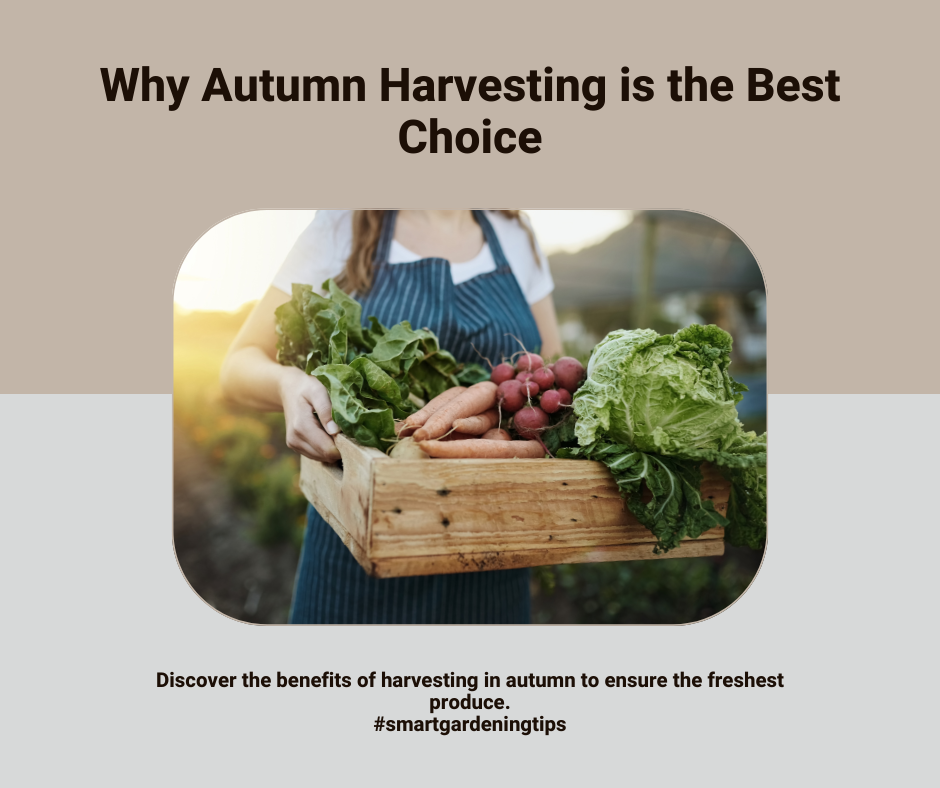
1. Extended harvest window: By harvesting in autumn, you can often extend your harvest window, allowing you to enjoy fresh produce for a longer period. This means less reliance on store-bought fruits and vegetables and more access to homegrown goodness.
2. Higher nutritional content: Many fruits and vegetables reach their nutritional peak in autumn. By choosing to harvest during this season, you can ensure that you’re getting the maximum health benefits from your homegrown produce.
3. Ideal weather conditions: Autumn often brings stable temperatures and reduced pest activity, creating optimal conditions for successful harvesting. You can avoid the scorching heat of summer or the frost of winter, ensuring that your crops have the best chance of reaching maturity.
4. Vibrant flavors: The cooler temperatures of autumn allow certain crops to develop their flavors fully. From sweet and crisp apples to rich and earthy root vegetables, autumn produce offers a wide range of delicious flavors that can take your recipes to the next level.
| Benefit | Description |
|---|---|
| Extended harvest window | Harvesting during autumn allows for a longer period of fresh produce availability. |
| Higher nutritional content | Fruits and vegetables often reach their nutritional peak during the autumn season. |
| Ideal weather conditions | Stable temperatures and reduced pest activity create optimal conditions for successful harvesting. |
| Vibrant flavors | Cooler temperatures allow certain crops to develop their flavors fully, resulting in more delicious and flavorful produce. |
Embrace the importance of autumn harvesting and make the most out of this bountiful season. Your garden will thank you, and your dinner table will be filled with the freshest and most delicious homegrown produce.
Planning Your Autumn Harvest
When it comes to planning your autumn harvest, there are several key factors to consider. From selecting the right crops to understanding their growing requirements, careful planning can ensure a successful harvest and bountiful yields. Here are some expert tips to help you make the most of your autumn garden.
Choosing the Right Crops
One of the first steps in planning your autumn harvest is choosing the right crops to cultivate. Not all plants thrive in cooler temperatures, so it’s important to select varieties that are well-suited for autumn harvesting.
- Opt for cold-hardy crops: Look for vegetables and fruits that can withstand chilly temperatures, such as kale, carrots, beets, and winter squash.
- Consider the timeline: Different crops have varying growth rates, so consider the time it takes for a particular crop to mature before choosing it for your autumn garden. This will help ensure you have enough time to harvest before the first frost arrives.
- Succession planting: To maximize your yield throughout the autumn season, consider succession planting. This involves sowing multiple batches of the same crop at staggered intervals to ensure a continuous harvest.
Understanding Growing Requirements
Each crop has its own specific growing requirements, and it’s crucial to understand these factors when planning your autumn harvest. Pay attention to factors such as soil temperature, sunlight exposure, and watering needs to create the ideal growing conditions for your chosen crops.
- Soil preparation: Prepare your soil by adding compost or organic matter to improve its fertility and drainage.
- Light requirements: Ensure that your garden receives adequate sunlight during the day. Most crops require at least six hours of direct sunlight for optimal growth.
- Watering: Pay attention to the water needs of your crops, providing sufficient moisture without overwatering. Use mulch to help retain soil moisture and prevent weed growth.
- Frost protection: As autumn temperatures drop, be prepared to protect your crops from early frosts. Covering them with row covers or cloths can help shield them from the cold.
By carefully selecting the right crops and understanding their growing requirements, you can effectively plan your autumn harvest for a successful and rewarding season.
Preparing Your Garden for Autumn Crops
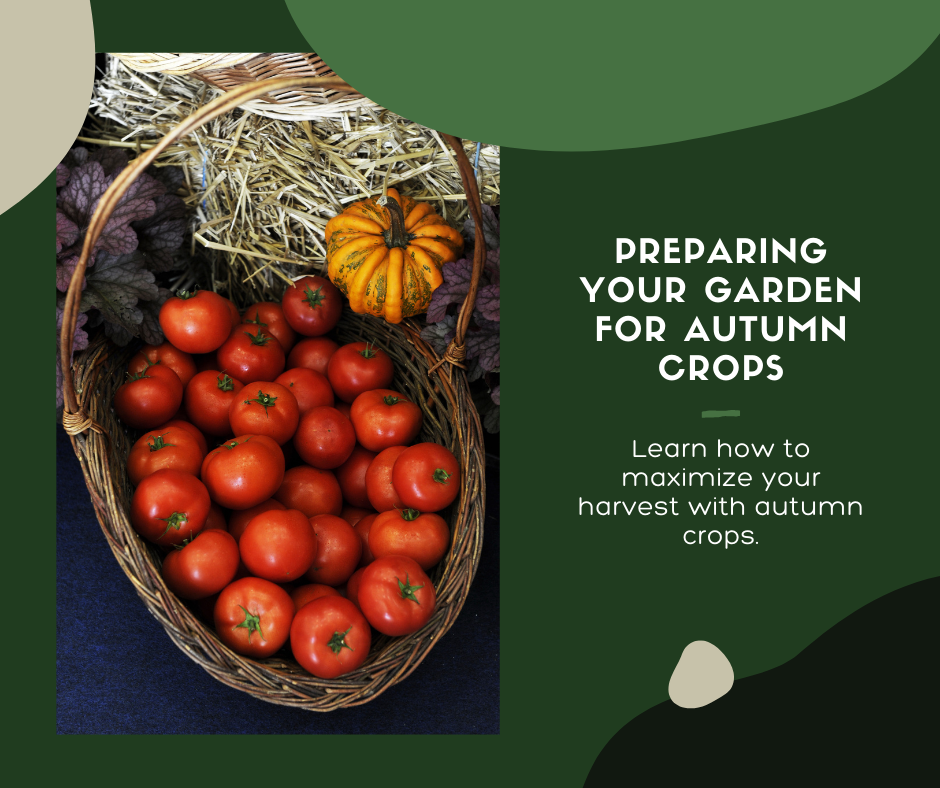
As the summer season comes to an end, it’s time to start preparing your garden for autumn crops. Taking the necessary steps to ensure your garden is ready for the new season will contribute to a productive harvest. Here are some valuable tips to help you get started:
- Clean up the garden: Begin by clearing out any remaining summer plants and weeds. Remove debris and fallen leaves to create a clean and healthy environment for your autumn crops.
- Amend the soil: Before planting your autumn crops, it’s crucial to improve the soil quality. Add organic matter such as compost or well-rotted manure to enrich the soil with essential nutrients. This will promote healthy growth and increase the yield of your crops.
- Choose the right crops: Select crops that are suitable for autumn harvesting. Some popular options include broccoli, spinach, kale, and radishes. Consider the specific climate and conditions in your area to determine the best crops for your garden.
- Provide adequate drainage: Ensure that your garden has proper drainage to prevent waterlogged soil, which can lead to root rot and other plant diseases. If necessary, make adjustments to improve the drainage by adding gravel or creating raised beds.
- Protect against pests: As the temperature drops, pests may seek shelter in your garden. Take preventative measures by installing physical barriers or using organic pest control methods to protect your crops.
“Preparing your garden for autumn crops is essential to set the stage for a successful harvest. By implementing these tips, you’ll create a conducive environment for your plants, ensuring they thrive and produce a bountiful yield.”
Remember, each garden is unique, so adapt these tips based on your specific needs and conditions. With proper preparation, you’ll be on your way to a thriving autumn garden.
| Crop | Planting Dates | Harvest Time |
|---|---|---|
| Broccoli | Mid to late summer | Autumn and early winter |
| Spinach | Late summer to early autumn | Throughout autumn |
| Kale | Mid to late summer | Autumn and winter |
| Radishes | Late summer to early autumn | Early autumn |
Tips for Successful Autumn Harvesting
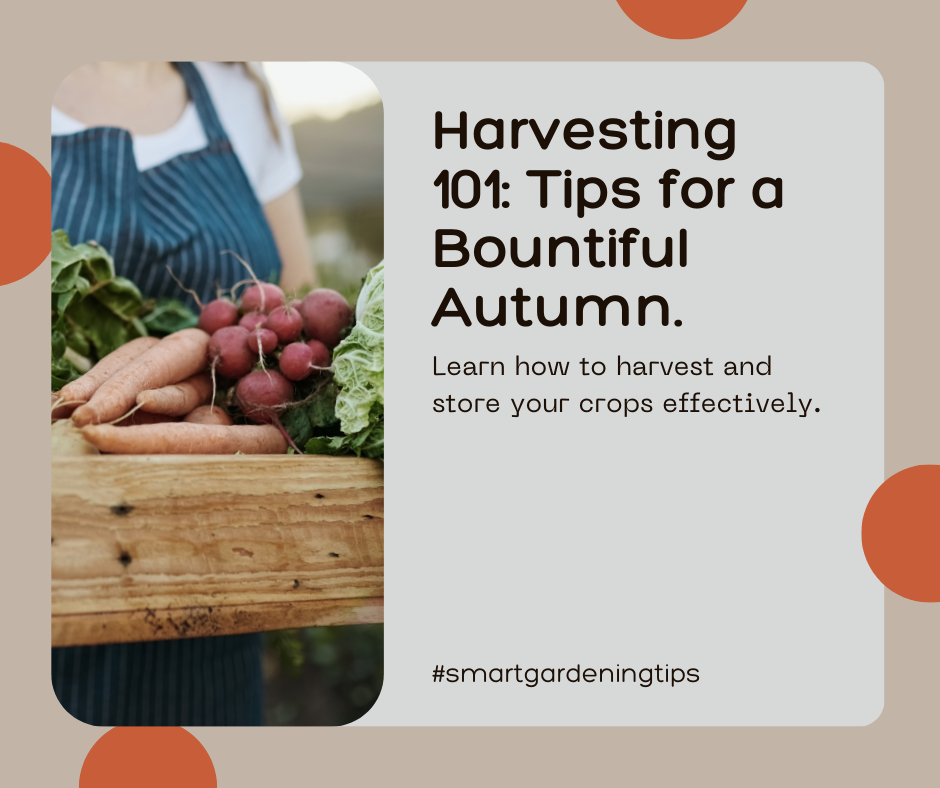
When it comes to harvesting autumn crops, following some key tips and best practices can greatly enhance your success. By optimizing your technique and implementing these expert recommendations, you’ll be able to make the most of this bountiful season and achieve a abundant harvest. Here are some essential tips to help you maximize your autumn harvesting:
1. Timing is essential
Pay close attention to the optimal time for harvesting each specific crop. Different plants have different maturity levels, so harvesting at the right time ensures the best flavor, texture, and nutritional value. Stay informed about the specific indicators of ripeness for each crop you grow.
2. Be mindful of weather conditions
Keep an eye on weather forecasts and plan your harvesting accordingly. Ideally, choose a dry day to avoid excessive moisture on your crops, as it can lead to fungal diseases and spoilage. Harvesting during the cooler parts of the day can also help preserve the freshness and quality of your crops.
3. Handle fruits and vegetables with care
When harvesting, handle your crops with utmost care to minimize damage. Use sharp, clean tools to avoid unnecessary bruising or tearing. Gently lift and support the plant, especially when uprooting root vegetables, to prevent breakage and root damage.
4. Follow proper storage and preservation techniques
After harvesting, it’s important to store and preserve your produce correctly to extend its shelf life. Clean your crops thoroughly and remove any damaged or bruised parts. Consider storing different crops separately, as some produce releases ethylene gas, which can accelerate ripening and spoilage in others.
Expert Tip: Don’t wash your vegetables and fruits before storing them, as moisture can lead to decay. Instead, store them unwashed in cool, dry places or in suitable storage containers.
5. Utilize appropriate storage methods
Learn about the best storage techniques for different crops. Some vegetables, like carrots and beets, prefer cool, dark environments with high humidity, while others, such as tomatoes and peppers, do well in room temperature areas with low humidity. Experiment with different storage methods to find what works best for each crop.
6. Preserve the flavors through freezing and canning
If you have an abundance of crops, consider preserving them through freezing or canning. Freezing locks in the flavors and nutrients of your harvest, allowing you to enjoy them throughout the year. Canning, on the other hand, helps maintain the taste and quality of your produce by sealing it in jars with the necessary acids and heat.
7. Share the harvest
Autumn is a time of abundance, so consider sharing your harvest with friends, family, or local community organizations. It’s a wonderful way to spread joy, build relationships, and contribute to your community.
By following these tips and implementing the best practices for harvesting autumn crops, you’ll be well on your way to a successful and fruitful harvest. Enjoy the rewards of your hard work and savor the flavors of the season!
Storing and Preserving Harvested Produce
Once you have harvested your fresh produce, it’s essential to know how to properly store and preserve it to extend its lifespan and enjoy the fruits of your labor for as long as possible. The right storage techniques will ensure that your autumn harvest remains fresh, delicious, and nutritious.
Here are some effective methods for storing and preserving your harvested produce:
- Proper Temperature and Humidity: Different fruits and vegetables have specific temperature and humidity requirements for storage. It’s important to store each item at its ideal conditions to maintain flavor and prevent spoilage. Refer to the table below for some common produce storage guidelines.
- Cool and Dark Area: Find a cool and dark area in your home, such as a pantry or basement, to store your harvested produce. Avoid storing them near sources of heat or direct sunlight, as this can accelerate spoilage.
- Separate and Sort: Some fruits and vegetables release ethylene gas, which can cause nearby produce to ripen faster or spoil. To prevent this, store ethylene-producing fruits separately. Additionally, sort your produce and remove any damaged or overripe items to prevent them from spoiling the entire batch.
- Canning: Canning is a popular preservation method that involves sealing produce in airtight jars. It is particularly effective for items like pickles, sauces, and jams. Follow proper canning techniques and guidelines to ensure safety and longevity.
- Freezing: Freezing is an excellent method for preserving a wide range of fruits and vegetables. It helps retain flavor and texture while extending storage life. Properly blanching or packing items in airtight containers or bags will help maintain their quality.
- Drying: Drying is an age-old technique for preserving produce. It removes moisture, preventing the growth of bacteria and mold. Different drying methods such as sun-drying, air-drying, or using a dehydrator can be used based on the type of produce.
Remember to label and date your stored produce to keep track of freshness and use them in a timely manner. With these storage and preservation methods, you can savor the flavors of your autumn harvest throughout the year.
| Produce | Storage Temperature | Storage Humidity |
|---|---|---|
| Apples | 32°F (0°C) | 90-95% |
| Carrots | 32°F (0°C) | 90-95% |
| Tomatoes | 50-55°F (10-13°C) | 85-90% |
| Leafy Greens | 32°F (0°C) | 90-95% |
Expert Tip:
“When storing produce, it’s important to regularly check for any signs of spoilage. Remove any rotting or moldy items immediately to prevent them from affecting others.” – Sarah Gardner, Horticulture Expert
By implementing these storage and preservation techniques, you can make the most out of your autumn harvest and enjoy delicious homegrown produce throughout the year.
Autumn Harvesting Tools and Equipment
When it comes to autumn harvesting, having the right tools and equipment is essential for a successful and efficient harvest. The proper equipment not only saves you time and effort but also ensures that your crops are handled with care. In this section, we will explore the must-have tools and equipment needed for a bountiful autumn harvest.
1. Garden Fork
The garden fork is a versatile tool that is indispensable during the autumn harvest. Use it to loosen the soil, remove weeds, and gently lift root crops such as carrots and potatoes. Its sturdy tines and ergonomic handle make it easy to work with, providing maximum control and minimizing damage to your crops.
2. Harvest Knife
A harvest knife is a vital tool for quickly and efficiently harvesting vegetables and fruits. Its sharp, curved blade allows for precise cutting, minimizing damage to the plant and ensuring a clean harvest. Use it to safely harvest delicate crops like lettuce, cucumbers, and tomatoes.
3. Pruning Shears
Pruning shears are not only for pruning trees and shrubs but also for trimming and harvesting autumn crops. With their sharp blades and ergonomic design, pruning shears provide clean cuts, promoting healthy plant growth and preventing the spread of diseases. Use them to harvest herbs, leafy greens, and smaller crops.
4. Garden Scissors
Garden scissors are perfect for harvesting herbs, flowers, and smaller vegetables. Their compact size and precise blades allow for easy and accurate cutting. Whether you’re harvesting fresh herbs for cooking or gathering beautiful blooms, garden scissors are a must-have tool for any gardener.
5. Harvest Basket or Bag
A sturdy and spacious harvest basket or bag is essential for collecting your freshly harvested produce. Look for a basket or bag with handles and a durable construction, allowing you to easily transport your crops from the garden to your kitchen. With its ample space, it minimizes the risk of damaging or bruising the harvested produce.
Remember, having the right tools can make all the difference in your autumn harvest. Invest in high-quality equipment that suits your specific gardening needs, and you’ll be well-prepared for a successful and rewarding season of harvesting.
Comparison of Autumn Harvesting Tools and Equipment
| Tool | Features | Benefits |
|---|---|---|
| Garden Fork | Versatile tool for loosening soil and lifting root crops | Minimizes damage to crops and provides maximum control |
| Harvest Knife | Sharp, curved blade for precise cutting | Efficiently harvests delicate crops with minimal damage |
| Pruning Shears | Sharp blades for clean cuts | Ensures healthy plant growth and prevents disease spread |
| Garden Scissors | Precise blades for accurate cutting | Perfect for harvesting herbs, flowers, and smaller vegetables |
| Harvest Basket or Bag | Spacious and durable construction | Minimizes produce damage during transportation |
Recommended Equipment for Efficient Harvesting
When it comes to autumn harvesting, having the right equipment can make all the difference in ensuring a smooth and efficient process. Investing in high-quality tools and machinery will not only save you time and energy but will also help maximize your yield. Here are some recommended equipment options that can streamline your harvesting and make it more efficient:
- Garden Scissors: These handy tools are essential for precise and delicate cutting of vegetables and herbs. Their sharp blades and ergonomic design make them easy to use and enable you to harvest crops without causing any damage.
- Harvesting Knife: A sharp and sturdy knife is a must-have for efficient harvesting. It allows you to quickly and cleanly cut through thick stems and tough skins, making the process much easier.
- Pruning Shears: Especially useful for harvesting fruits and tree crops, pruning shears enable you to efficiently cut branches and stems without exerting excessive force. Look for shears with a comfortable grip and sharp blades for the best results.
- Harvesting Apron: Keep your harvested produce organized and within reach with a durable harvesting apron. It not only provides convenient storage for your fruits and vegetables but also keeps your hands free for a more efficient workflow.
- Harvesting Crates or Baskets: Sturdy crates or baskets are essential for collecting and transporting your harvested produce. Opt for ones with handles and enough capacity to accommodate your harvest without causing any damage.
- Wheelbarrow: If you have a larger garden or orchard, a wheelbarrow will be your best friend during harvesting season. It allows you to transport a significant amount of produce at once, reducing the time and effort required.
- Harvesting Gloves: Protect your hands from thorns, prickly stems, and other potential hazards with a pair of durable and comfortable gardening gloves. Look for gloves that offer a good grip and allow for dexterity.
Remember, having the right equipment not only makes your harvesting process efficient but also contributes to the quality and freshness of your produce. Invest in these recommended tools and machinery to ensure a successful autumn harvest!
Preserving Your Harvested Produce
After a successful harvest, you’ll want to make sure that you can enjoy the fruits of your labor for as long as possible. Preserving your harvested produce is not only a great way to extend its freshness but also allows you to savor the flavors of autumn throughout the year. In this section, we will explore different methods for preserving vegetables and fruits, including canning, freezing, and drying.
Canning: One popular method for preserving vegetables and fruits is canning. This process involves sterilizing jars, filling them with fruits or vegetables, and sealing them to create an airtight environment. Canning allows you to safely store your produce for long periods while retaining their nutritional value and taste. Whether you prefer making jams, pickles, or canned vegetables, the possibilities are endless.
Freezing: Freezing is another effective method for preserving your autumn harvest. It involves freezing fruits and vegetables at sub-zero temperatures to halt the growth of microorganisms that cause spoilage. Freezing retains the nutrients and flavors of your produce, making it a convenient and versatile preservation option. From blanching and flash-freezing to making frozen purees or soups, freezing is a simple yet effective way to enjoy your harvest year-round.
Drying: Drying is a traditional preservation method that removes moisture from fruits and vegetables, making them less susceptible to bacterial growth. Whether you choose sun drying, dehydrator drying, or oven drying, this technique allows you to preserve the intense flavors of your harvest while also concentrating their nutritional value. Dried fruits and vegetables make excellent additions to baked goods, trail mixes, and savory dishes.
Each preservation method offers its own unique advantages and considerations. The choice depends on the type of produce and your personal preferences. Experiment with different techniques to find the ones that suit your needs best. Below is a table summarizing the key differences between canning, freezing, and drying:
| Preservation Method | Advantages | Considerations |
|---|---|---|
| Canning | Long shelf life, versatile, preserves flavors | Requires equipment, time-consuming |
| Freezing | Convenient, retains nutrients, no additional ingredients | Requires freezer space, shorter shelf life |
| Drying | Intense flavors, concentrated nutrients, space-efficient | Requires additional equipment, longer drying time |
By preserving your harvested produce, you can enjoy the taste of autumn long after the season ends. Whether you choose canning, freezing, or drying, each method ensures that your hard work pays off. Experiment with different preservation techniques to create a pantry filled with delicious treats that will delight your taste buds throughout the year.
Caring for Your Autumn Harvest
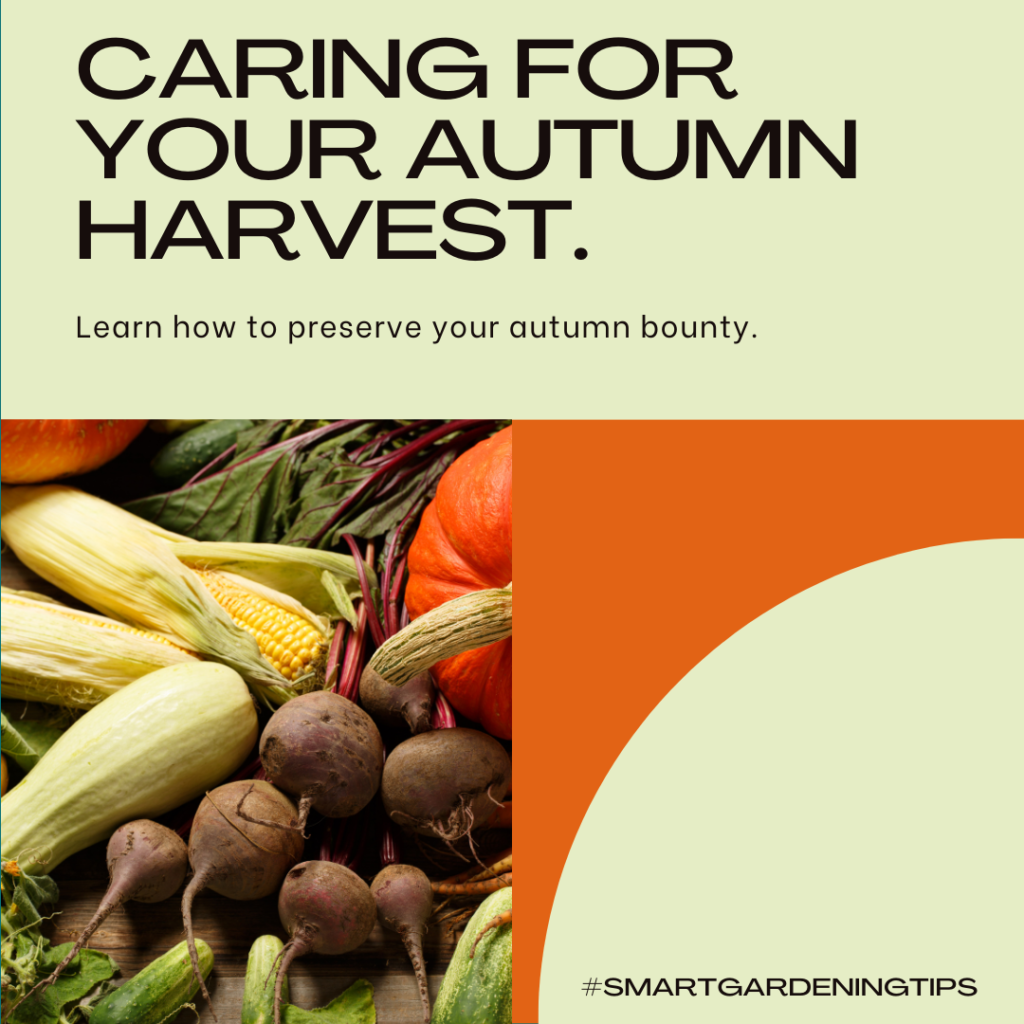
Once you’ve successfully harvested your autumn crops, it’s crucial to take proper care of them to maintain their freshness and quality. Follow these post-harvest tips to ensure your hard-earned yield stays in optimal condition:
1. Handle with Care
Handle your harvested produce gently to minimize damage and bruising. Rough handling can lead to spoilage and reduced shelf life. Treat your crops delicately to preserve their quality.
2. Remove Excess Debris
Before storing your harvested crops, make sure to remove any excess leaves, stems, or dirt. Cleaning your produce helps prevent the spread of diseases and keeps your storage space clean.
3. Sort and Separate
Sort your harvested crops based on their maturity levels and condition. Remove any damaged or spoiled fruits or vegetables to prevent them from negatively impacting the entire harvest. Separate different varieties to avoid cross-contamination and maintain their flavor profiles.
4. Proper Storage Conditions
Optimal storage conditions are crucial for preserving the freshness of your autumn harvest. Store your crops in a cool, dry, and well-ventilated environment. Avoid exposing them to direct sunlight or high levels of humidity, as these can accelerate spoilage.
You can also utilize various storage methods, such as:
Canning: Preserve your fruits and vegetables by canning them in jars and sealing them properly to prevent spoilage.
Freezing: Freeze your produce to extend its shelf life. Properly package and label them to ensure they remain well-protected.
Drying: Dehydrate certain fruits and vegetables to create flavorful snacks or ingredients that can be stored for an extended period.
By employing these preservation techniques, you can enjoy the fruits of your autumn harvest even during the colder months.
5. Regularly Check for Spoilage
Regularly inspect your stored crops for any signs of spoilage, such as mold or rot. Remove any affected produce immediately to prevent the spread to other items within your storage space.
6. Rotate Your Stock
To ensure you use your harvested produce efficiently, practice stock rotation. Use the oldest items first to minimize waste and maximize freshness. This way, you can enjoy the full benefits of your autumn harvest.
With these post-harvest tips, you can extend the lifespan of your autumn crops and savor their delicious flavors for longer.
FAQ
Q. Why is autumn harvesting important?
A. Autumn harvesting is important because it allows you to make the most of the bountiful season. It ensures that you can maximize your yield and enjoy the benefits of fresh, homegrown produce during the autumn months.
Q. What are the benefits of harvesting during the autumn season?
A. Harvesting during autumn has several benefits. The cooler temperatures and milder weather create optimal growing conditions for certain crops. Additionally, the flavors of certain fruits and vegetables tend to be richer and more intense when harvested during this time.
Q. How do I plan my autumn harvest?
A. Planning your autumn harvest involves considering factors such as the duration of the growing season, the maturity time of different crops, and the availability of space in your garden. It’s important to choose crops that thrive in cooler temperatures and can withstand potential frost in the later months.
Q. What are some tips for preparing my garden for autumn crops?
A. To prepare your garden for autumn crops, start by removing any summer plants that have finished producing. Clear away debris and weeds, and amend the soil with organic matter to ensure it’s in optimal condition for planting. You may also want to consider installing protective structures like row covers or cold frames to extend the growing season.
Q. How can I ensure successful autumn harvesting?
A. Successful autumn harvesting can be achieved by practicing proper watering and fertilization techniques, closely monitoring pests and diseases, and implementing effective weed control. It’s also essential to harvest crops at their peak of ripeness and to store them in appropriate conditions to maintain their quality.
Q. What are some methods for preserving harvested produce?
A. There are several methods for preserving harvested produce. Canning involves placing fruits or vegetables in jars with a preservation liquid, whereas freezing requires packaging the produce in airtight containers and storing them in the freezer. Drying involves removing moisture from the produce, often by using a food dehydrator or oven.
Q. What tools and equipment do I need for autumn harvesting?
A. Essential tools for autumn harvesting include pruning shears for trimming plants, a garden fork or shovel for digging up root vegetables, and a basket or box for collecting the harvested produce. Additionally, depending on the scale of your harvest, you may need larger equipment such as a wheelbarrow or garden cart.
Q. What equipment is recommended for efficient harvesting?
A. Recommended equipment for efficient harvesting includes a harvesting knife or scissors for precision cutting, a garden rake or cultivator for removing weeds, and a garden hose or watering can for convenient watering. It can also be helpful to have a garden apron or bucket for carrying tools or collecting small harvests.
Q. How do I best care for my autumn harvest after harvesting?
A. After harvesting, it’s crucial to handle your crops with care to avoid bruising or damaging them. Remove any excess soil or debris and gently wash the produce if necessary. Store different types of fruits and vegetables in appropriate conditions, such as cool and dry storage for root crops and refrigeration for certain fruits and leafy greens.
Conclusion
In conclusion, autumn harvesting is a crucial activity for any gardener looking to maximize their yield and enjoy a bountiful harvest. By following expert advice and implementing best practices, you can make the most out of this vibrant season and ensure the success of your garden.
Autumn harvesting offers numerous benefits, including the opportunity to harvest a wide variety of crops that thrive in cooler temperatures. The cooler weather provides ideal growing conditions for vegetables such as kale, spinach, carrots, and beets, resulting in higher yields and better flavor.
Furthermore, autumn harvesting allows you to extend the lifespan of your produce, ensuring that you can savor the flavors of your garden long after the season ends. By properly storing and preserving your harvested produce through techniques such as canning, freezing, and drying, you can enjoy the fruits of your labor throughout the year.
So, as autumn approaches, embrace the opportunity to plan your harvest, prepare your garden, and utilize the recommended tools and equipment to optimize your success. By implementing the tips and best practices outlined in this guide, you can confidently embark on an autumn harvesting journey that will yield an abundance of fresh, flavorful, and nutritious crops.
















